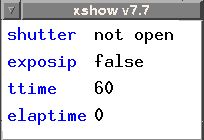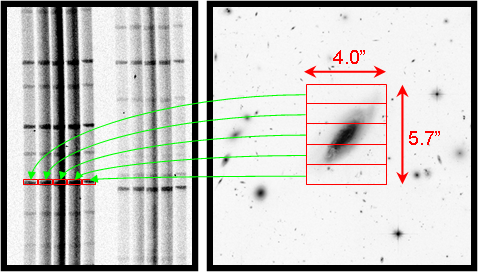Instrument Status
| Subsystem |
Status |
| Triple wheel |
Working AOK. Currently-loaded elements in the slit wheel
are:
- Clear
- Echellette slits
- Integral Field Unit (IFU)
- 1.0 arcsec low-dispersion longslit
- 0.75 arcsec low-dispersion longslit
Please contact your support astronomer in advance of your
run if you will need any slit not listed above.
|
| Guider |
Replaced guider, focus delta fixed. |
| Calibration lamps |
All lamps working AOK. |
| Rotator |
Ok |
| CCD |
OK to observe.
- Reported detector temperature is warmer than normal.
- Detector performance unchanged
- Dewar LN2 hold time is 18-20 hours.
|
Key:
No problems -
Problems -
Broken
Instrument News
Jan 11, 2022 -- Dashboard Countdown
Discrepancy
We have had 2 instances where the ESI Dashboard GUI countdown shows
exposure time remaining even after the exposure completes. We think
this is due to a memory issue with the Dashboard GUI and should be
fixed by restarting the Dashboard.
Additionally, we have added an xshow to the control0 VNC desktop
to show relvant exposure info. If there is a discrepancy between
the Dashboard and the xshow, the xshow is correct.
| xshow image |
xshowExposure Description |
 |
- shutter
- Shutter status: "open" or "not open"
- exposip
- Exposure in progress: "true" or "false"
- ttime
- Total exposure time: in seconds
- elaptime
- Elapsed exposure time: in seconds
|
Feb 16, 2021 -- Detector temperature
reading higher than normal
After a weather-induced warmup, ESI did not reach its normal
operating temperature range of -115 to -120 degC. It now reads
between -95 to -100 degC
Some evidence indicates the temperature sensor may be reading
incorrectly
- Dewar hold time remains >18 hours
- Dewar ion pump continues to function normally
- The bias voltages have not changed to keep the bias about 1000 DN
- The dark current looks unchanged


Jan 26, 2016 -- DVD writer no longer available for data backups
The Keck Observatory is phasing out the auto DVD writer
sometimes used by observers for data backups. Options to
launch the DVD autobackup gui are no longer available from
the background menu. Because the
Keck Observatory Archive (KOA) now ingests all raw data from every
instrument at the observatory, observers are encouraged to use KOA to retrieve
a copy of the data following your observing
sessions. Instructions and links to possible methods of data
backup including KOA, scp, and rsync are found at:
BackingUp.
DVD writer for data backups will be phased out
(2014-Mar-7)
The Keck Observatory is phasing out the auto DVD writer
sometimes used by observers for data backups. Although there
is no time line for the removal of the DVD writer, we will no
longer troubleshoot or maintain the DVD writer. Because the
Keck Observatory Archive (KOA) now ingests all raw data from every
instrument at the observatory, observers are encouraged to use KOA to retrieve
a copy of the data following your observing
sessions. Instructions and links to possible methods of data
backup including KOA, scp, and rsync are found at:
BackingUp.
05 Nov 2012 - New ESI Calibration Tool Released
We are pleased to announce the initial release of the ESI Calibration Tool which automates the
process of gathering biases, darks, flats, and arcs for ESI.
13 Jul 2012 - New ESI Exposure Time Calculator
Released
Xavier Prochaska and Brad Holden of UCO/Lick have released a nice web-based exposure-time calculator for ESI.
24 Oct 2011 - Keck starlists can now contain
RA/Dec offsets
In response to a recent observer request, the MAGIQ guider
software has been updated to allow observers to specify RA and
Dec offsets to be applied after a target has been centered up.
The intention is to permit starlists to contain entries for
alignment stars with known offsets to a faint science target
which may not be visible on the guider. As described in the
starlist
documentation, the new keywords to include are
raoffset and decoffset. The offset
values listed in the starlist file can be read directly into
the MAGIQ offset fields, thus avoiding the need to verbally
relay telescope offsets to the Observing Assistant (with the
corresponding risk of a miscommmunication). If you have any
questions about how to specify offsets in your startlist file,
please contact your Support Astronomer for assistance.
09 Sep 2011 - ESI Throughput Measurements
Updated
Xavier Prochaska's web page of ESI
efficiency has been updated with new measurements acquired this
month.
24 May 2011 - ESI Signal-to-Noise Estimator
Now Online
Jason Prochaska and Brad Holden of UCO/Lick Observatory has created an
signal-to-noise
estimation tool for ESI. We hope that observers will find this
tool useful in computing exposure times for ESI and welcome feedback
on the software.
08 June 2010-ESI Starts All-VNC-All-The-Time Operation
ESI is the first Keck instrument to formally switch to using VNC
full-time for operations; other Keck instruments will transition to
this mode shortly. For several years we have employed VNC to share
instrument control windows with remote observers on the mainland; this
will now become the full-time operating mode for ESI. By doing so, we
will thus have a single startup procedure for observers to follow
regardless of whether or not they will operate with mainland
observers. Operating under VNC also makes it easier for support staff
to assist observers with troubleshooting, and allows our observing
assistants to monitor the status of observations during the night.
Your support astronomer will be happy to assist you with starting your
ESI software under VNC.
31 January 2010-ESI IFU Released
The ESI Integral Field Unit (IFU) has completed its commissioning
phase, providing a new ESI observing mode which offers
medium-resolution spectroscopy for extended targets. Developed at
UCO/Lick by Andy Sheinis and Joe Miller, the unit employs an image
slicer arrangement to reimage a contiguous 4.0×5.7 arcsec
field of view into 5 separate spectra covering 20 arcsec of slit
length with a slit width of 1.13 arcsec. The resulting
echellette-mode spectra cover the normal ESI wavelength range of
0.37—1.0µm at a resolution of R=3500. Throughput
for the unit itself is only 45-55%, reducing the advantage of the
greater field of view, but for certain programs this new capability
for ESI will produce greater observing efficiency.

|
|
Right: Simulation of a possible target for the ESI IFU, a
galaxy much wider than the typical ESI slit. The red boxes indicate
the 5 slitlets in the IFU.
Left: Simulated ESI spectrum consisting of 5 individual
spectra correponding to the 5 slitlets in the IFU.
|
For further information on the IFU, please refer to the ESI IFU documentation and the corresponding article by Andrew
Sheinis.
12 January 2007-ESI Repair Effort Begins
With assistance from Jeff Lewis of UCO/Lick Observatory, Keck staff
removed the triple wheel assembly from ESI and shipped it to Lick for
replacement of the triple wheel bearings. We expect to get the
repaired assembly back in early February and to have it ready for use
in March.
Fall 2006-Middle Wheel Bearing Failure
During the fall of 2006, the middle wheel on ESI began to fail moves
regularly. Investigation revealed what appears to be a bad bearing on
the middle wheel, causing the wheel to stick and moves to fail. The
middle wheel was locked into the "decker" position to permit use of
the instrument in echellette mode only during the November and
December ESI runs. The entire triple wheel assembly is slated for
removal and servicing at UCO/Lick Observatory in Jan-Feb 2007, with a
return to fully-operational service in Mar 2007.
13 June 2005-Problem with Middle Wheel
In the one-night June observing run we encountered a fatal problem with
the middle wheel. This wheel contains the aperture mask and a couple of
filters. Unfortunately there was a filter in the beam when the failure
occurred, and we could not get to the clear position and limp along
for the night.
The problem appears very similar to the problem with the upper wheel
seen in 2004 March. In the latter case the
culprit was a failing harmonic drive that had vibrated loose a
number of set screws, keys, etc. Investigation into the current
problem is ongoing.
17 December 2004-New Web Page Design!
You will notice a new Web page design on the ESI home pages. As part of
a concerted effort to overhaul the Web pages, we are also including a
new design that will make the pages easier for us to maintain and
provide observers with more useful and attractive documentation.
Note that these pages will contain elements best viewed in a modern
browser, such as Netscape 7, Firefox 1.0, Safari, etc. Bear with us
while we make this transition, and report any major anomalies or
problems.
17 December 2004-ESI Guider Problems
The December 2004 run of ESI found us struggling with guider problems,
and we had to switch over to DEIMOS for a few observers. The original
problem appears to have been caused by a bad video cable to the guider's
camera head, but we also found cooling fans that were bad in the
controller. No sooner had we fixed those problems than the camera's shutter
died. While we have ocntingency plans in place for a shutter that dies in
the open position, this one died in the closed position.
8 March 2004-Slit Wheel Problems
For a number of months we have been having very sporadic failures of the
slit wheel to converge to its requested position. Early in semester
2004A this problem rapidly worsened. Requiring us to tear into the
triple wheel motor and gear box, we found what we thought was a
smoking gun: a loose set screw on a coupler. Diagnostic tools were
put in place and showed that we still had a potential problem. Further
ESI observing showed that we did indeed have further problems, and
upon deeper investigation we found a bad gear box. The set screw
found originally had come loose because of the vibration caused by the
bad gearbox.
We now have diagnostic tools, including a set written by De Clarke
of UCO/Lick Observatory, that will help us identify this type of problem
earlier, and avoid loss of observing time. Thanks to the Lick Observatory
crew that helped with diagnosis and repair of the problems!
15 November 2002-ESI Shutter Broken and Fixed
Observers on 2 November 2002 found that the ESI shutter was not operating
properly. After some troubleshooting it was determined that the night should
proceed with the shutter used in "single-blade" mode. In this mode only
one of the two blades (the working one) is used to shutter the exposures.
Subsequent analysis of the shutter by summit crew showed that the problematic
shutter blade was working fine, but not triggering the limit switch. The limit
switch was adjusted and the shutter tested. It is now fully operational.
27 September 2002-Minor GUI modification
Some of you may notice on your upcoming runs that the button previously
labeled "STOP" on the ESI GUI has been renamed "PANIC!". Some observers
did not understand that "STOP" meant to stop all motors immediately and
lock them out of control. It was meant to be an emergency measure
in case some terrible problem threatening life, limb, or equipment
occurred while motors were moving. Instead, some observers thought that
it meant "Stop the current exposure" or "Cancel the current motor
move request (but don't lock me out of control!)". "PANIC!" more
accurately reflects the purpose of the button.
27 September 2002-Revised spatial scales in echelle mode
The pinholes in the MultiHoles mask have been carefully measured
in imaging mode and scaled by the astrometrically-determined imaging
pixel scale. (The MultiHoles images are separated by 2.695 +/- 0.020
arcsec on average.) This has led to a revision in the pixel scale
along the slit for each of the echelle orders. The new numbers
are given in the Quick Reference
link as well as in the Observer's Manual.
18 August 2002-Dome flat recommendations
At least one observer has recommended dome flats for echelle mode,
rather than internal flats. In general it is hard to create the same
illumination pattern on the spectrograph optics with light reflected
from just in front of the slit.
Whether this affects only the most critical calibrations or all
data remains to be seen. Feedback from other observers would be
appreciated. Just e-mail the
ESI Scientist with comments. Mahalo!
9 July 2001-GUI Facelift
A few relatively minor modifications have been made to ESI's
Dashboard GUI. The most obvious will probably be seen in the
"QuickFrame" buttons on the main GUI and in the CCD detail panel.
There are now options for setting windowing and binning for full-frame
images taken in normal (1x1) binning, 1x2, 2x1, and 2x2 binning.
Note that these buttons change the window definitions, the binning,
and the number of amplifiers.
Some other changes:
- The TV warnings that would invariably pop up on the screen
during instrument initialization have been removed.
- The initialization has now been made slightly faster by fixing a
minor bug in the script. It now takes roughly 3 minutes to initialize
everything.
- The initialization routine also effectively does a "Clear Desired"
after it completes, so that it does not leave you with a bunch of yellow
buttons that request an old configuration.
- The triple wheel has been relabeled to agree with our finally
adopted naming convention: upper, middle, and lower wheels.
- The Init. Run button on the User Config (or "Start Here!") pop-up
has been removed. This was confusing some observers, causing them to
delete the information just entered for observer, file root name, starting
file number, and directory.
5 July 2001-New Echelle Slits Accurately Aligned and Available
The new echelle slits (see below)
have been accurately measured, and new wheel positions defined to place
them in the same position in the focal plane. This should help if you
ever need to calibrate the wavelength of spectra taken with one slit
using data from a different slit. (E.g. spectra taken with the 6 arcsec
echelle slit may be difficult to wavelength calibrate on their own.)
These new slits are now the default (the old slits have been removed
from the instrument).
21 May 2001-New Line of Holes for Echelle Calibration
A feature of the new echelle slit mask is a line of holes lying
along the slit direction. This
"MultiHoles" position of the
upper wheel in ESI will allow you to calibrate the relative
spatial scale along the slit as a function of order, and give you
a set of traces as a function of position along the slit.
In the latter context, remember that atmospheric dispersion may
cause your stellar trace to deviate from the traces defined by the slits!
21 May 2001-Improved Illumination of the Echelle Slits
A new echelle mask, tilted at a different angle than the old one,
has now been tested on sky. The previous echelle mask had maximum
sensitivity at the very top of the mask, not near the slit centers
as observers would like. The new mask tilt provides optimum illumination
near the slit centers. It also has a better-formed 0.3-arcsec pinhole,
and (see above) a line of holes. Each slit position of the mask must
still be tested before being released to the observers, although
the MultiHoles position (a new feature) has been calibrated and
released for use this run.
21 May 2001-A New Coma-Correction Tool for ESI
ESI (as well as LRIS-R and possibly LRIS-B) contains some internal coma,
in part because of its design as an off-axis instrument. Since tilting
the secondary a small amount primarily adds coma into the image,
it allows for two observing modes with ESI: spectroscopic mode, for
which the secondary tilt is used that optimizes the image quality
in the telescope focal plane, and imaging mode, for which the secondary
tilt produces a coma opposite to the instrumental coma, providing
a nearly coma-free field at the science detector. Note that in
imaging mode the secondary tilt depends on the physical rotator angle.
In spectroscopic mode it does not.
Previously the OAs and observers had no easy way of switching between
modes, other than to run a fresh MAlign and analyze the images in the
appropriate manner. With the new coma.tcl
tool MAlign is run in its default mode, the tilts (which correspond
to spectroscopic mode) are loaded into coma.tcl at the click of a button,
and then the user has full control over the secondary tilts via two
buttons-labeled "Spectr." and "Imaging"-for the rest of the night.
Results from a new MAlign can be loaded again at the click of a button.
This software is currently released on a shared-risk basis. It has
been tested during the engineering run in 2001 March.
More can
be learned from the documentation.
3 November 2000-MAKEE now available for data reduction!
Tom Barlow has graciously extended the capabilities of his echelle reduction
package, MAKEE, to accomodate ESI data. Currently only 1x1 binned, full-frame
echelle data have been proven. See Tom's
MAKEE
Web page for HIRES for details.
The ESI numbered accounts should have integrated
access to MAKEE by the time you observe next.
MAKEE is a highly automated echelle reduction package which is ideally suited
for both quicklook reduction and for full data reduction.
3 November 2000-autocopy, for copying data to HQ scratch disks
For a number of years observers have been using
``copymon'' for automatically
copying HIRES, LRIS, and (more recently) ESI data to HQ scratch directories,
primarily for backup and quicklook reduction capabilities. (Remember, you
should NOT reduce data on the same disks that raw data is written to!)
ESI account menus now feature
``autocopy,''
an automated form of copymon
that creates a directory on an HQ scratch disk and starts the copy monitor.
As the ESI keywords signal that another image has been written to disk,
copymon then copies it to the HQ directory automatically.
3 May 2000-Guider Concerns (updated 25 May 2000, 3 November 2000)
Nov. 2000 update: Low-D slit work has been on hold until we determined
what the appropriate slit tilt was for optimizing the illumination on
the TV guide/acquisition camera. The current slit tilt places the
best illumination at the top of the slit mask, not at slit center as it should.
During the October engineering run a new tilt was determined, which will allow
the Lick shops to proceed with cutting new slit masks.
In addition, a user-friendly, click-and-drag interface to creating subwindows
has been created for the OAs, which will allow them and observers to concentrate
on small regions of the guider rather than being limited to full-chip readout
There are two major concerns about the guider. First, the illumination
around the low-D slits is terrible, making it difficult to center
targets. The slit masks themselves are not being held properly, and
one is being sent back to Lick for analysis. Some
details are provided for the engineers.
Update: The Lick shops have found that the holders for the low-D slits
were cut poorly, and they are cutting a new test holder and developing
gluing techniques to improve the slits. However, this will not
benefit the upcoming late May/early June run.
The focus also varies across the guider field, and during an upcoming
engineering run we will measure this and see whether it is more
consistent with a tilt in the TV CCD or a discontinuity between the
offset field and the slit.
On the plus side, we are now using a subwindow around the slit to
speed up centering. This cuts the time per image by 12 seconds (!)
in 1x1 binning. Flat fielding the guider images has also been demonstrated
but not fully tested.
3 May 2000-Web index
On the ESI Home Page there is an Index, which
should make finding some things easier on the Web pages. It is not complete
yet, and probably will not be 100% complete for a long time.
If you see some grievous omission, let us know!
14 February 2000-Sandra Castro's IRAF reduction Web page
Sandra Castro of Caltech has put together a nice set of instructions
for of ESI data.
14 February 2000-Echelle "Wavelength Finder"
On the Web is a new "wavelength finder"
for echelle mode. It is a small JAVA program that shows an image of
the CCD and allows you to click on different parts and readout the
wavelength of that location. We hope to upgrade it in the future to
allow you to select from a number of canned images: wavelength calibration
spectra, night sky spectra, and flat field.
There is also a hope to get a better version of this installed into
FIGDISP, so that observers can read wavelengths directly off their
data images. Currently the JAVA program does not support the import
of arbitrary FITS images, nor is there any intention of doing so.
1 February 2000-New low-D slits (updated 14 Febraury 2000)
We have receiving from the Lick shops a full set of new low-dispersion
slits. They use a new material which should cut much cleaner
than the old slits. They arrived in time for the early
February 2000 run. Remember that only three of them can be installed at
one time, leaving a fourth position open for imaging and the fifth
position for the echelle slits.
1 February 2000-Dewar rotated
In echelle mode the arc lines and night sky lines were tilted previous
to 26 January 2000. The tilts varied across the echelle format, but
averaged around 0.6°. At the wavelengths of the [O I] 5577, 6300,
and 6363 night sky emission, and the OH emission lines in the near-IR,
the tilt was closer to 0.7°.
The dewar was rotated to correct for this, with a very slight residual
tilt amounting to about 1/3 pixel or less across the entire length of
the slit. This dewar rotation should help improve night sky subtraction
in echelle mode.
1 February 2000-Data reduction help
There is more information, such as wavelength plots
and even wavelength solutions,
on the Web now which should help observers reduce their data.
We are in the process of accumulating a full set of sample images
to make available on the Web, now that the dewar rotation has been
performed (see above).
27 December 1999-End of Commissioning
ESI is now almost fully commissioned, and will start science observing
tomorrow night with Prof. George Djorgovski of Caltech.
A manual written by Mike Bolte is available on the Web, although
it will undergo changes as we get more data and more experience in
using the system with different science observers.
Mike Bolte is also working on a data reduction description for IRAF
users. We also hope at some point to get Tom Barlow's HIRES reduction
system working with ESI data.
Most notable, the entire Web site will now be changing from its original
"commissioning" design to its more or less final design. This will
take some time, but will put a great deal more information at the fingertips
of users. Please have patience, and e-mail if you cannot find the
information you want.




